LEOPARD GECKO CARE SHEET
Eublepharis macularius
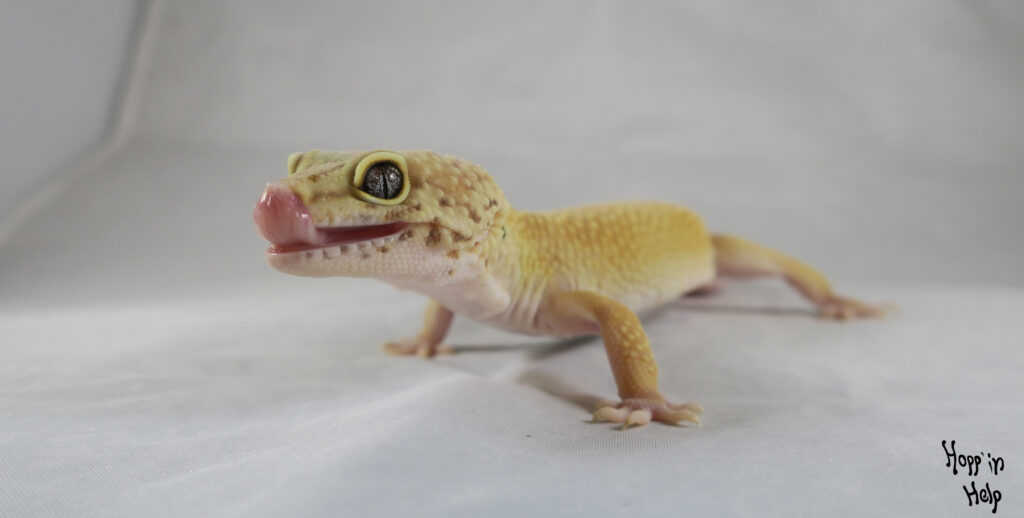
PERSONAL EXPERIENCE: Leopard Geckos are amazing and were my very first reptile! Filled with personality and are just plain out adorable. These chunky geckos here are my number one suggestion for new reptile owners.
CAPTIVITY DIFFICULTY: Beginner
LIFE SPAN: 10-20 years. Bad genetics and poor care results in shorter lives.
ACTIVITY: Leopard Geckos are crepuscular, meaning they are active from dusk to dawn. During the day, you will find your gecko napping around their enclosure. When they are super comfy they “sploot”! This is when they lay with one to all arms back, kind of like a baby. If you see your gecko doing this, they are okay and are actually very comfy!
It is also important to note that they may be awake every once in a while during the day. If you enter the room, they may greet you like a puppy at the front of the glass. Also, any noise that may sound like possible food could wake them. However, at night is their prime hours. This is when they will walk around their enclosure, get a sip of water, and when you should feed them. Typically after a bit of exercise, your gecko will spend the rest of the night lounging about.
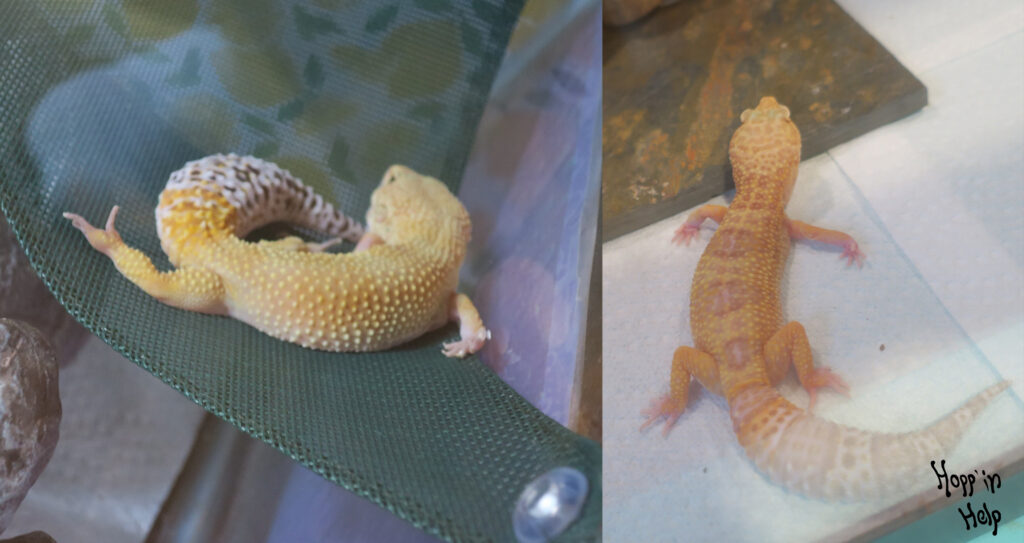
ENCLOSURE: Leopard Geckos require a fairly simple enclosure compared to other species, this being one of the main reasons I suggest them for beginners. But is also not an excuse to only provide the bare minimum. I will not be sharing how to create a bio-active enclosure in this care sheet. Bio-active enclosures have far different requirements and are far more difficult for beginners to properly create. However, bio-active enclosures are incredible for Leopard Geckos and great for enrichment! I highly suggest upgrading once you are comfortable, but a proper enclosure that is not bio-active is just as good.
Leopard Geckos require a heat gradient. Reptiles cannot sweat, therefore they must move to a colder area to cool down. Heat from below is needed for digestion. I personally prefer head pads or tape over heat bulbs, but either or may be used. Place your heat pad to the far right or left below your glass enclosure. This side is now the designated “Warm” side.
For substrate, you may use paper towels, natural slate tiles, or both. While this may take some time for your gecko to establish, I place the paper towel in the area they use the restroom to make cleaning super easy! Some people also use non adhesive shelf liners! Never use sand, calcium sand, or walnut shells. Leopard Geckos are native to rocky semi-arid regions in South Asia. Sand will be ingested and cause impaction. Walnut shells can also cause impactions and scrape up the soft underbellies of your gecko.
Leopard Geckos then require at least three hides. A warm hide, a humid hide, and a cold hide. A warm hide must be placed over the heating pad, the humid hide should stay in the middle, and the cool side on the far opposite side of the warm area. A humid hide is needed for when your gecko begins to shed. They enter this hide to help remove and then eat their shed. Geckos eat their shed because it is super nutritious! For a step by step on how to create a humid hide, click the button below. Rock, cave, wood, and other reptile hides are perfect for the other 2+ hides. While Zoo Med, Zilla, & more brands have great hides I suggest checking out Stroodies on Etsy. They make amazing 3D printed hides and I use their products in all of my enclosures. A small water dish is needed and fresh water must always be available. I suggest placing the water dish on the cool side to prevent increased evaporation which leads to raising the humidity of the enclosure.
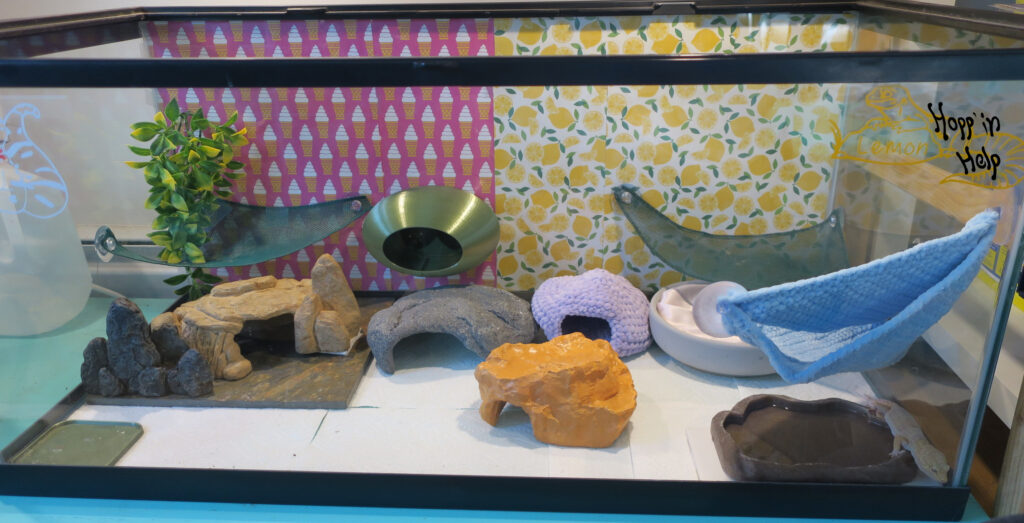
Hides and a small water dish are necessities, but more leads to a better and healthier life! Think of it that you need a bed but your bedroom has much more in it. Hammocks, leafy vines, drift wood, life or false plants, and dig bins are great additions. I highly suggest low hanging hammocks because most geckos love them and it is a nice resting area to help their joints.
A dig bin is a great enrichment tool for your gecko. I suggest using something with a lid to keep the eco earth contained but anything works! I personally used a shallow succulent dish filled with dry eco earth, a coconut fiber substrate, to fill the dig bin. A Tupperware with a hole cut into the lid works as well. (Ensure the cut has smoothed edges, covering the edges with electrical tape works). Do not use any sort of sand in the bin.
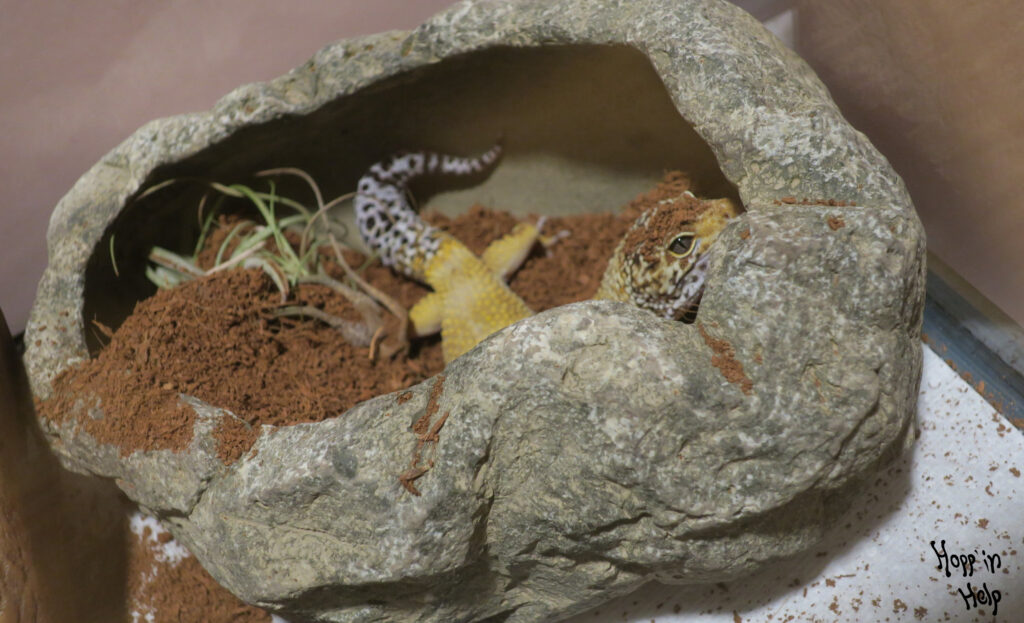
SIZE OF ENCLOSURE: A 20 Gallon Long or 40 Gallon Breeder make perfect homes for your Leopard Gecko. Geckos enjoy “homey” enclosures so bigger is not necessarily better.
HUMIDITY: 30-40% (Average home humidity)
TEMPERATURE GRADIENT: Leopard Geckos require a heat gradient. Unlike us, they cannot sweat or put a jacket on so you must provide a range of temperatures. Place the heat pad that matches the gallon size of your enclosure, on the far right or left. This establishes the warm area. Basking temperatures should be 90-95 F (32-35 C). This is the temperature of the stone they lay on, not necessarily the air. Surface Temperature guns are perfect at checking the temperature.
Temperatures should then gradually reach 75-80 F (24-26 C) on the cool side. This is a measurement of air temperature. Purchasing a thermometer is best to determine proper temperatures. I suggest a thermometer and hygrometer placed on the cool side. Linked below is my favorite brand and style.
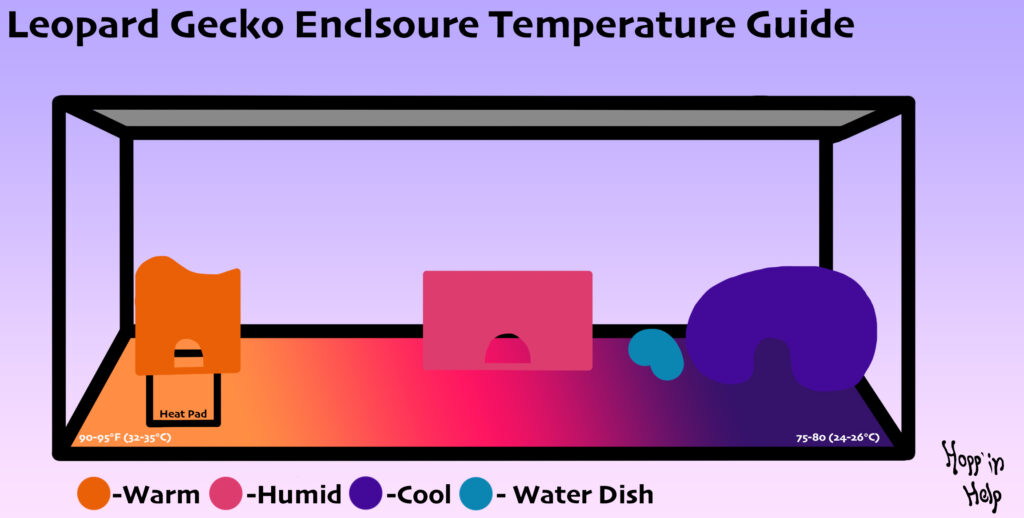
UVB LIGHTING: UVB is not needed for Leopard Geckos. These geckos are nocturnal therefore they naturally do not absorb a lot of sunlight. However, they do need “daylight” to have proper day and night cycles. This can be a fluorescent bulb, room light, open window (sun cannot directly shine in the enclosure), etc. Simply a light that will act as the sun so they know when to sleep.
By feeding your gecko calcium powder with vitamin D3, you are giving your gecko the nutrients their body would make with their small exposure to UVB light. If you do choose to have a UVB bulb you must ensure it is the proper intensity. I suggest a 2.0 linear bulb on for 8 hours a day. 9 am to 5 pm with other light to simulate the full 12 hours of sunlight. If you have an albino morph, I suggest against UVB because they are extremely sensitive to the light.
FEEDING: Leopard Geckos are strict insectivorous, meaning they only eat insects! Crickets and/or Dubia Roaches should be their staple diet. For a young Leopard Gecko, under a year old, feed daily. About 2 crickets/roaches per inch of your gecko from head to tail. For adults, feed every other day. I personally feed Monday, Wednesday, and Friday. Feed 3 crickets/roaches per inch. Remember a diverse diet leads to a happy and healthy gecko! Horn worms, meal worms, wax worms, and other bugs serve as great treats to incorporate in their meals. Check the chart below for snack instructions.
SNACKS:
- Horn Worms: Wonderful way to hydrate your gecko. These large green worms are full of good nutrients and are fun for your gecko to eat. Beware though that they are very fatty! I would feed only 3-4 Horn Worms a month. (Tip! Only get 3 or 4 at a time because they grow insanely fast!)
- Wax Worms: These worms are a great way to fatten up a rescue gecko. However, they are addicting, literally! Just like little kids who want chips for dinner, your gecko will only want these tasty treats if you give them too often. I personally suggest only using these to fatten malnourished geckos and using horn worms as a treat for healthy geckos.
- Meal Worms & Super Worms: Why are meal worms not apart of their staple diet? Unlike what most pet stores say, meal worms are actually very difficult for geckos to digest! Their shell is made of chitin which can cause impactions if given in large amounts. I would only give 1-2 worms a month as a crunchy treat.
- Black Soldier Larvae: These bugs are relatively new to the reptile world. Studies so far state that they are a great source of calcium. Giving a few of these larvae here and there can be very beneficial to them!
SUPPLEMENTS: Dusting your feeders with calcium with D3 greatly improves your gecko’s health and is needed. With D3 is required if you do not provide UVB. Only give calcium if you do provide UVB. Their body used UVB light to produce D3 and they can overdose if given it supplementary too!
A multivitamin should be given every other week, I suggest Repashy Calcium Plus.
Do I need a calcium bowl? Depends on the gecko! I highly suggest leaving a small dish full of powder in a rescued gecko’s enclosure. Geckos who need calcium badly will eat it straight from the dish. However healthy geckos may also do this which leads to “armpit bubbles”. Under the front arms of your gecko, they begin storing the extra nutrients in large bubbles. In the wild, they do this to store up nutrients that may become unavailable. However, in captivity they just become overweight. Whether your gecko should have a dish or not should be discussed with your exotic vet.
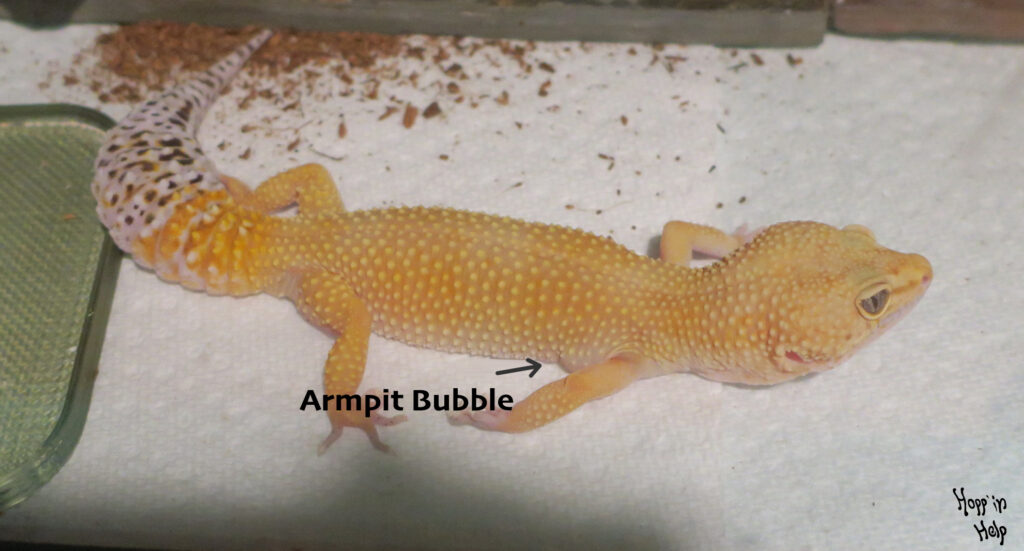
HOW TO SEX: Thankfully it is very easy to tell if your gecko is a girl or a boy! Where the back legs meet, if there is a row of femoral pores, they are male, and if there is not, they are female!
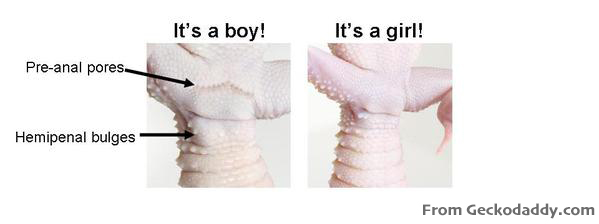
SIZE: Depending on your gecko’s morph, size varies. The average size of an adult ranges from 7-9 inches (17-23 cm). Males tend to be larger than females.
GECKO TAILS: Leopard Geckos can in fact lose their tails and they have the ability to grow back but sometimes cannot if they are in poor conditions. You very very much do NOT want your gecko to drop its tail. They do this when they believe prey is about to eat them. The tail drops in hopes that the animal trying to eat them will go for the detached twitching tail and not them. If your gecko drops their tail, they are in unfit, stressful conditions that needs immediate change.
After the tail has dropped, the gecko may get an infection. You must go to an exotic vet to ensure the wound is clean. Most tails grow back deformed and your gecko may have a lack of movement in the tail.
What does a healthy tail look like? Chunky! Fat tails mean a healthy gecko! You may notice that most pet store geckos have thin tails. Bad genetics, poor enclosures, and diets lead to thin tails. While your gecko’s tail may not be as huge as others, because it can be genetic, you still want the gecko to be “large” for the body type!
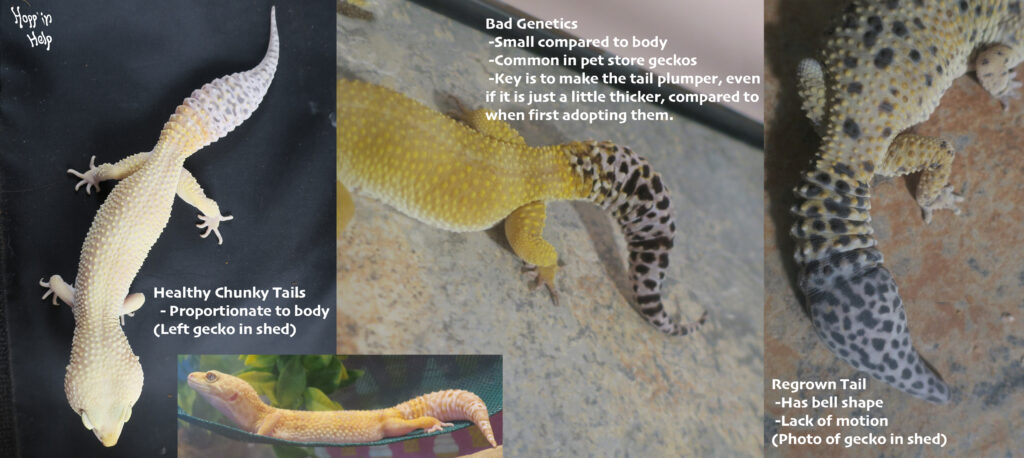
I AM NEW TO REPTILES, ARE THEY GOOD FOR BEGINNERS?
Yes! Leopard Geckos are my number one suggestion for new reptile owners. With simple care and enclosure maintenance, they are great for someone who has never done care like this before. Please remember though that they are living beings and exotic animals who require an exotic vet and checkups just like a dog or cat!
